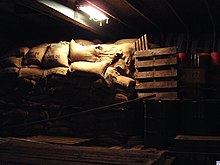Hold

The cargo hold - colloquially also cargo hold - is the space in the ship that is intended for the storage and transportation of cargo.
Also in aircraft those areas are cargo space or cargo space called where cargo is transported. If it is attached below the cabin , it is referred to as an underfloor cargo area .
The rear part of a combination motor vehicle ( "combination") is also referred to as a cargo space, see trunk .
General
The cargo hold generally takes up the largest part, in the case of ships without a double hull even the entire width of the ship. The cargo space is delimited at the bottom by the floor of the cargo space, to the side by the outer skin or, in the case of a double hull, by this and at the top by the hatch cover. In almost all contemporary ships, the cargo hold floor is formed by the tank ceiling . This in turn forms the upper end of the raised floor .
The volume of the hold or the holds of a ship is measured and specified in two ways, grain space (also: grain space or bulk material space) and ball space. The grain space is always larger than the ball space, with the difference between about five to ten percent.
- The grain space of the hold is measured at the height from the upper edge of the tank ceiling to the lower edge of the deck panels and including the hatch. The width of the grain space measures from the inside edge to the inside edge of the side walls of the hold and, in single-hulled ships with open frames, also includes the spaces between the girders and frames. In the longitudinal direction, the grain space is measured from the front edge to the rear edge of the hold and open depressions such as companionways, storage compartments and the like are included in the overall space.
- The ball space of the hold is measured at the height from the upper edge of the tank ceiling to the lower edge of the deck beams and excluding the hatch. The width of the ball space measures from inside edge to inside edge of the cargo hold side walls and, in the case of single-hulled ships with open frames, from inside edge to inside edge of the frames or welding battens. In the longitudinal direction, the ball space is measured from the front edge to the rear edge of the cargo space and open depressions such as companionways, storage compartments and the like are excluded from the overall space.
Holds of various types of ship are designed to meet the requirements of the goods to be transported. So have general cargo ships , for example, holds with one or more intermediate deck , reefers have insulated holds and tanker cargo holds are designed as tanks. The hold of larger ships is usually divided lengthways by transverse bulkheads . Liquid goods and a number of bulk goods require the shipbuilding arrangement of longitudinal bulkheads for reasons of stability . Because of their cargo, container ships are designed as open ships .
Furthermore, the holds of ships can often be adapted to changing loads. Automobile bulk carriers or tank bulk carriers are examples of ship types designed to carry alternating loads.
Container ships
The hold of container ships is designed as an open hatch without an under- stowage. This enables any position in the room to be reached directly vertically by a crane. On full container ships , the hatches are equipped with so-called cell guides. The containers are placed in the room in these cell guides. You have the advantage that there is no need for lashing, as the containers are secured by the Cellguides. The hold on a larger container ship is divided into several hatches, the tank ceiling is not designed for point loading, but for surface loading.
Multipurpose cargo ships
On multi-purpose ships , the hold is divided into several hatches (the number of hatches depends on the size of the ship). These ships usually have an intermediate deck , which either only has a fixed position or is height adjustable several times (usually two to three different heights).
Since these ships are suitable for many different types of cargo, they have no cell guides or the like. On modern ships, the hold is designed as an open hold. The tank top is designed for point loading, not area loading. This is particularly important when driving particularly heavy loads such as steel coils . If the tank top does not have the necessary strength, it will deform.
Bilges
The hold of older general cargo ships usually has two bilges on the side, the hold of modern dry freighters three to four bilges (one or two forward and two aft). These hold bilges are used to drain liquids in the hold. This can e.g. B. rainwater that penetrates through open hatches. The bilges are pumped in the ship's engine room via a pipeline system. If a dangerous liquid should escape from a cargo, it can be pumped out using a dangerous goods pump designed as a diaphragm pump.
literature
- Author collective: Stahlschiffbau . transpress Verlag, Berlin 1989, ISBN 3-341-00410-6 .
- Detje, Peter (ed.): Shipbuilding for boaters . Eckhardt & Messtorff Verlag, Hamburg 1962.
- U. Scharnow: Lexicon of seafaring . various years, transpress VEB Verlag für Verkehrwesen Berlin, ISBN 3-344-00190-6 , page 320

